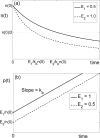Model of bleaching and acquisition for superresolution microscopy controlled by a single wavelength
- PMID: 22076257
- PMCID: PMC3207365
- DOI: 10.1364/BOE.2.002934
Model of bleaching and acquisition for superresolution microscopy controlled by a single wavelength
Abstract
We consider acquisition schemes that maximize the fraction of images that contain only a single activated molecule (as opposed to multiple activated molecules) in superresolution localization microscopy of fluorescent probes. During a superresolution localization microscopy experiment, irreversible photobleaching destroys fluorescent molecules, limiting the ability to monitor the dynamics of long-lived processes. Here we consider experiments controlled by a single wavelength, so that the bleaching and activation rates are coupled variables. We use variational techniques and kinetic models to demonstrate that this coupling of bleaching and activation leads to very different optimal control schemes, depending on the detailed kinetics of fluorophore activation and bleaching. Likewise, we show that the robustness of the acquisition scheme is strongly dependent on the detailed kinetics of activation and bleaching.
Keywords: (100.6640) Superresolution; (180.2520) Fluorescence microscopy.
Figures






References
LinkOut - more resources
Full Text Sources
